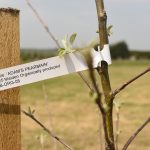ENHANCING THE ENVIRONMENT
Native species have been selected to blend in with the surrounding countryside and to add to the biodiversity of the site and surrounding area. The species mix has created natural habitats for insects, birds and small mammals.
All but a few of the trees and shrubs added to the site have come from Pershore College of Horticulture, which specialises in preserving the type of ancient native species that are the backbone of the site’s planting scheme.
The College recommended the MM106 rootstock, and the Quince A equivalent, which produce a medium-sized tree that can be maintained at an optimum height to provide adequate screening – while at the same time not interrupting views between locations outside of the site.
Most will become fruit-bearing after three to four years, which means our eyes are mostly fixed on 2022. For others, like our pear root-stocks, we’ll have to wait until 2023, at the earliest.
- Key: H Hedging / O Orchard / W Ecological and wildlife area / P Paddock
HEDGING
The hedging trees and shrub planting is continuous, not intermittent, expect where our deer have their wildlife corridor.
BLACKTHORN (H)
- Blackthorn (Prunus spinosa) has a white blossom in spring. Its sloe fruit is used to make gin.
- Site positions: Northern, Eastern, Southern and Western boundaries
- Number: 167
CHERRY (P)
- The Cherry (Prunus) Black Prince is a long-established dessert cherry that arose in the West Midlands, areas of which became well known for their cherry growing.
- Site position: The Paddock
- Number: Two
CRAB APPLE (H / W)
- The Crab or Wild Apple (Malus) grows from 20 to 50-feet tall, though it’s often seen as a bush. In May, its crooked branches are decorated with fragrant flowers – a beautiful addition to the Blossom Trail – and in the autumn the fruit appears, a ripe time for cider or jelly-making
- Site positions: Western boundary / Ecological enhancement and Wildlife area
- Number: Three
DOG ROSE (H)
- Dog rose (Roseosa canina) is deciduous and can range from three to 15 feet in height, though sometimes it can scramble higher into the crowns of taller trees, such as the Field Maple and Hazel in this landscaping scheme
- Site positions: Western boundary / Southern boundary
- Number: 67
FIELD MAPLE (H)
- Field Maple (Acer campestre) grows to between 50 and 80 feet tall as a tree. We’ve used it as low-level hedging and trees. It flowers in spring at the same time as the leaves open, and is insect-pollinated
- Site positions: Southern boundary
- Number: 60 (hedging), seven (trees)
HAWTHORN (H)
- The Common Hawthorn (Crataegus monogyna), also known as May. Occurs in a wide variety of soil types throughout the British Isles
- Site positions: Northern, Eastern, Southern and Western boundaries
- Number: 259
HAZEL WHIP (H)
- Hazel (Corylus avellane) has broad yellow leaves, and showy male catkins in early spring, followed by edible nuts in autumn. They’ve been planted as young ‘whips’, about two feet tall
- Site positions: Southern boundary
- Number: 60
HOLLY (H)
- The Holly tree or bush (Ilex aquifolium) is used as hedging in our landscape. The berries are an important food source for many birds like Redwings, Fieldfares and Mistle Thrushes
- Site positions: Western boundary / Northern boundary
- Number: 90
HONEYSUCKLE (H)
- Honeysuckle (Lonicera periclymenum) is a twining shrub that can grow up to 10 feet tall. Pollination is mainly carried out by hawk moths
- Site positions: Southern boundary / Northern boundary
- Number: 58
OAK (H)
- English Oak (Quercus robur) can range from 50 to 82-feet in height. Ours won’t be there for a generation or two yet
- Site positions: Western boundary / Northern boundary
- Number: Seven
ORCHARD TREES
The orchard and ecological / wildlife area trees are:
APPLE (O)

Adam’s Pearmain, one of the apple varieties recommended by Pershore College of Horticulture.
- Apple (Malus domestica) flowers in spring – another addition to the spring colour in the Vale – and flowers in late summer / early autumn. Pershore College of Horticulture recommend the MM106 rootstock, to produce a medium-sized tree. As with the plum, this planting scheme mixes old varieties, to increase their presence in the landscape, with newer local varieties that crop more abundantly
- Site positions: The Orchard
- Number: 15
DAMSON (O / W)
- The Damson tree (Prunus domestica) blossoms with small, white flowers in early April and fruit is harvested from late August to September or October.
- Site positions: Northern boundary / The Orchard
- Number: Six
PEAR (O / W)
- The pear tree (Pyrus) has white flowers in spring – another colourful addition to the blanket of blossom – and can grow from eight to 26-feet tall, depending upon the rootstock. Pershore College of Horticulture recommended planting the ancient Doyenne du Comice variety
- Site positions: The Northern boundary as part of The Orchard
- Number: Nine
PLUM (O)
- Plum (Prunus domestica) produces blossom in early to mid-spring before fruiting in August / September. It grows to between nine and 26-feet, depending on rootstock. Pershore College of Horticulture recommended that this planting scheme use a Pixy rootstock to produce a smaller tree. We’ve mixed old varieties, to restore numbers in the area, with newer local yellow-fruiting varieties that will produce a more abundant crop than the old varieties.
- Site position: The Orchard
- Number: 14

